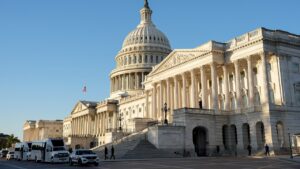The U.S. government has entered a shutdown after the Senate failed to pass a last-minute funding bill, potentially delaying the release of economic data as the nation’s federal economists and statisticians are placed on leave.
Among the affected agencies is the Bureau of Labor Statistics, which was scheduled to release a crucial employment report on Friday morning, which forecasts had indicated would reveal another weak period of jobs growth.
“Due to the federal government shutdown, the Bureau of Labor Statistics (BLS) will suspend data collection, processing, and dissemination,” the BLS told Newsweek.
Why It Matters
The shutdown will mean certain U.S. government services are paused, and pay is suspended for hundreds of thousands of employees. Economists have warned that a protracted shutdown could also harm economic growth.
The BLS “Employment Situation” report, which includes the unemployment rate as well as estimates for new jobs created in the previous month, is the most closely monitored gauge of labor market health, and a key touchstone for the Federal Reserve in guiding monetary policy.
What To Know
According to a contingency plan published last week by the Department of Labor, in the event of a shutdown, the BLS will “suspend all operations,” meaning data scheduled for release during the period will not be released and “all active data collection activities for BLS surveys will cease.”
It added that a prolonged shutdown would result in reports being delayed, as well as a “reduction in [the] quality of data collected.” It included a link to the BLS schedule, which showed 12 reports due for release this month, including Friday’s jobs report.
Last month’s Employment Situation report revealed that the economy added only 22,000 jobs in August, around a third of what analysts had forecast and extending the weak performance in July and June. July’s figures were revised up to 79,000 from 73,000, while June’s were revised down by 27,000, dropping from 14,000 to minus-13,000. The unemployment rate, meanwhile, edged up to 4.3 percent from 4.2 percent.
This report exacerbated concerns about a slowdown in the labor market—one expert told Newsweek it signaled a “persistent cooling trend”—and was seen as shifting the Federal Reserve’s priorities after months focusing on elevated inflation.
Friday’s jobs report was expected to be similarly gloomy. Forecasts from TradingEconomics had penciled in unemployment remaining steady at 4.3 percent in September, and nonfarm payrolls rising by only 50,000, greater than August’s total but well below historic averages.
This would likely deepen fears over the health of the labor market. The Conference Board announced on Tuesday that consumer confidence declined further in September, driven in part by concerns that employment conditions will continue to deteriorate in the near future.
Has the BLS Delayed Reports During Other Government Shutdowns?
During the last full government shutdown of 2013, which lasted 16 days, the BLS suspended operations, resulting in weeks of delays for both jobs and inflation reports.
“While releases were delayed, data quality for the period reflecting the shutdown was largely unaffected,” Wells Fargo economist Michael Pugliese wrote in a recent note, “with the BLS reporting normal-range response rates for the October 2013 employment and [Producer Price Index] reports.”
However, amid the partial shutdown that took place between December 2018 and January 2019, the BLS continued to release key data largely uninterrupted as the Department of Labor was among those funded by appropriations bills passed in September 2018.
No appropriations bills were passed ahead of the latest shutdown.
What People Are Saying
Brendan Greeley, contributing editor at the Financial Times, told MSNBC on Tuesday: “The employment report, which comes out the first Friday of every month, is the single most important piece of economic information that we get. Markets look to it; stocks trade on it; the Fed follows it, because it is the one thing that means the most to Americans.”
“It’s politically important, and it’s also economically important,” he added, “because the one thing that we all understand is whether or not we have a job.”
What Happens Next
In addition to the BLS, the Commerce Department has stated that monthly economic indicators from the Census Bureau will be delayed, and the Bureau of Economic Analysis will halt operations in the event of a shutdown.
Depending on the length of the shutdown, another key release from the BLS that could be affected is the Consumer Price Index, one of the main measures of inflation, that is due out on October 15.
The BLS told Newsweek it will still release the Metropolitan Area Employment and Unemployment release for August at 10 a.m. ET.
“Once funding is restored, BLS will resume normal operations and notify the public of any changes to the news release schedule on the BLS release calendar,” the bureau said.
Read the full article here














